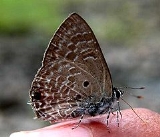
Anthene lycaenina
Encyclopedia
The Pointed Ciliate Blue (Anthene lycaenina) is a small butterfly
found in India
that belongs to the Lycaenids or Blues
family.
. In both sexes however, but especially in the male, the fore wing is distinctly narrower and more acute at apex and the hind wing more acutely angulated at the tornus
. In markings on the upperside the two forms are closely alike; on the underside they differ as follows:— Groundcolour similar but a shade darker. Fore wing: the transverse discal band dislocated below vein 3 and shifted inwards so that the short band on the discocellulars and the anterior portion of the discal band form the two branches, the lower portion of the discal band the stem, of a rough Y-shaped figure. Hind wing: a large black or dark brown white-encircled spot touching vein 7 near its base (in A. emolus there is never any trace of such spot). The discal and terminal transverse bands with their pale or white edgings much more broken, irregular and confused. Antennae, head, thorax and abdomen as in the female of emolus, but on the underside the palpi, thorax and abdomen whiter with a slight bluish tint.
Butterfly
A butterfly is a mainly day-flying insect of the order Lepidoptera, which includes the butterflies and moths. Like other holometabolous insects, the butterfly's life cycle consists of four parts: egg, larva, pupa and adult. Most species are diurnal. Butterflies have large, often brightly coloured...
found in India
India
India , officially the Republic of India , is a country in South Asia. It is the seventh-largest country by geographical area, the second-most populous country with over 1.2 billion people, and the most populous democracy in the world...
that belongs to the Lycaenids or Blues
Lycaenidae
The Lycaenidae are the second-largest family of butterflies, with about 6000 species worldwide, whose members are also called gossamer-winged butterflies...
family.
Description
Closely resembles Anthene emolusAnthene emolus
The Ciliate Blue is a small butterfly found in India that belongs to the Lycaenids or Blues family.-Male:Upperside: dull purple; bases of the wings suffused with blue ; both fore and hind wings with well-marked jet-black anticiliary lines, that on the fore wing expand slightly at tho apex...
. In both sexes however, but especially in the male, the fore wing is distinctly narrower and more acute at apex and the hind wing more acutely angulated at the tornus
Glossary of Lepidopteran terms
This glossary describes the terms used in the formal descriptions of insect species, jargon used mostly by professionals or entomologist....
. In markings on the upperside the two forms are closely alike; on the underside they differ as follows:— Groundcolour similar but a shade darker. Fore wing: the transverse discal band dislocated below vein 3 and shifted inwards so that the short band on the discocellulars and the anterior portion of the discal band form the two branches, the lower portion of the discal band the stem, of a rough Y-shaped figure. Hind wing: a large black or dark brown white-encircled spot touching vein 7 near its base (in A. emolus there is never any trace of such spot). The discal and terminal transverse bands with their pale or white edgings much more broken, irregular and confused. Antennae, head, thorax and abdomen as in the female of emolus, but on the underside the palpi, thorax and abdomen whiter with a slight bluish tint.
External links
- Asahi Correctly determined photos of Anthene lycaenina
See also
- LycaenidaeLycaenidaeThe Lycaenidae are the second-largest family of butterflies, with about 6000 species worldwide, whose members are also called gossamer-winged butterflies...
- List of butterflies of India
- List of butterflies of India (Lycaenidae)

